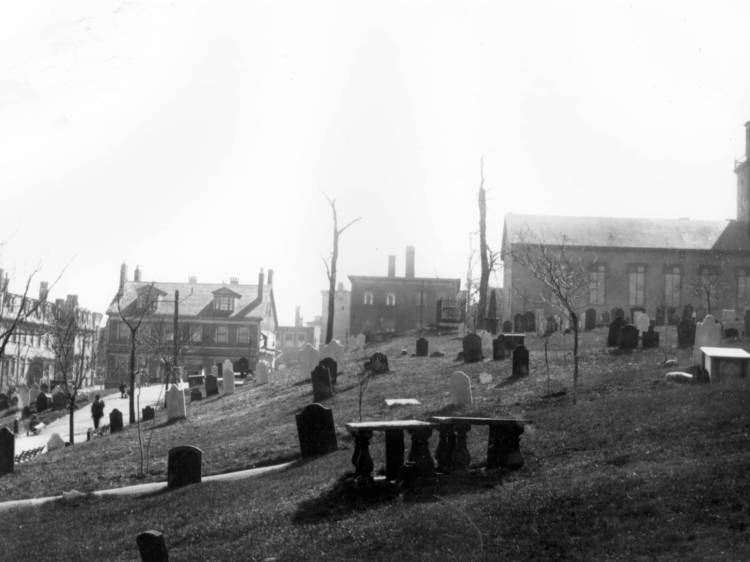The History Of Saint John
In the Beginning
The geology of Saint John is about 1.2 billion years old, and it was once connected to Africa. This land, the Wabanaki (Land of the Dawn), is the traditional territory of the Wolastoqiyik. The tribal groups belonging to the Wabanaki confederacy are Maliseet, Mi’kmaq, Passemaquoddy, Penobscot and Abenaki.
1535
The first European to explore this area was Portuguese explorer Estavan Gomez who, in 1535, identified a river on the east coast as the “Rio de la Buelta” (River of the Return).
1604
In 1604, Mi’kmaq gathered on Ouigoudi (Navy Island), where they watched a foreign-looking ship enter the harbour on June 24, St. Jean Baptiste Day. Aboard were Pierre Dugua, Sieur de Monts, and Samuel de Champlain. They charted the harbour and made note of the Reversing Falls Rapids. They named the river after Saint John, their patron saint.
1631
Almost 30 years later, in 1631, Charles de La Tour, the newly commissioned Governor of Acadia, built a fortified trading post as his headquarters at the mouth of the river. In 1645, the fort was captured by La Tour’s rival for governor, Charles d’Aulnay, after a valiant defence led by La Tour’s wife, Françoise Marie Jacquelin, while her husband was in Boston seeking aid from the English. A new tourism development interpreting the heritage of Fort La Tour has recently been developed at this site.
1713
In 1713, the Treaty of Utrecht ceded French Acadia, including the Saint John River Valley, to England. The French settlers were gradually displaced by colonists and traders from New England. The Massachusetts firm of Simonds, Hazen and White established a trading post at the river mouth in 1762, and the first permanent settlement in the area was established.
1774
In 1774 the American Revolution began, and bands of American rebels and privateers raided the eastern seacoast, which threatened to topple the Simonds, Hazen and White enterprise.
1777
Fort Howe was established in 1777 to safeguard the river from further attacks.
1785
At the end of the American Revolution, 14,000 Loyalist supporters of the British arrived at Portland Point en route to settle along the Saint John River, using land grants allotted to them by the Crown. Some of the Loyalists established two settlements, one on either side of the river mouth: Parr-Town on the east and Carleton on the west. In 1785, the two settlements were incorporated by charter into the City of Saint John – Canada’s first incorporated city.
1840s
Saint John also attracted an influx of immigrants, after the War of 1812, mainly from Scotland, England and the West Indies. In the 1840s, more than 30,000 Irish immigrants arrived in New Brunswick, mainly in Saint John. Many suffered from typhus. Later, immigrants from Germany, Denmark and Russia brought smallpox and cholera. Some were quarantined on Partridge Island.
Mid-1800s
The years that followed brought economic growth and social development. Saint John developed a prosperous timber trade and a wood shipbuilding industry, which was the third largest in the world by the mid-1800s.
1860s
The 1860s saw the city’s shipbuilding industry decline as steel steampowered vessels replaced wooden sailing ships. Canada’s oldest surviving wooden ship is the Egeria, built in Millidgeville in 1859 and now resting at Port Stanley in the Falkland Islands.
1867
Canada’s Confederation in 1867 dealt another blow to Saint John and to the Maritimes. In order to encourage Maritime trade with central Canada, the government of the new dominion imposed high tariffs on foreign goods, forcing Maritime businessmen to import costly materials from Ontario and Quebec.
1877
On June 20, 1877, a disastrous fire destroyed the city’s central business district and much of the residential south end. The task of rebuilding the city was an enormous one for Saint John’s citizens – but rebuild it they did, this time out of brick and stone in the commercial district and primarily wood in the residential areas. Better times were underway.
1880
Beginning in 1880, the railway expansion provided direct links with the rest of Canada, stimulating the flow of goods and commerce. Consequently, the port began to flourish and manufacturing boomed.
1910

Firefighter Alexander Long with a ladder wagon on skis in front of the St. John Presbyterian Church on King Street East.
Credit: Heritage Resources, Saint John1923
The shipbuilding industry was revived with the establishment of the Saint John Dry Dock in 1923.
1928

Old Public Burial Grounds (also referred to as the Loyalist Burial Ground) with the St. John Presbyterian Church in the background.
Credit: Heritage Resources, Saint John1939
Gradually, Saint John regained its prominence as an important manufacturing and shipbuilding centre. The city played a prominent role during the Second World War thanks to its dry dock and port faciliaties.
1942

No. 4 Fortress Signals Company.
Credit: Heritage Resources, Saint John1945
Post-war, entire neighbourhoods were built for veterans and their young families. Urban renewal wiped out other neighbourhoods and replaced them with new transportation links and commercial facilities. Saint John experienced suburban sprawl like most North American communities.
1950

King Street East, between Carmarthen Street, facing Wentworth Streets. A city transit bus is turning left down Wentworth Street.
Credit: Heritage Resources, Saint JohnToday
The story does not stop here. Today, Saint John – the only city on the Bay of Fundy – mixes centuries-old charm with a vibrant waterfront, a flourishing arts and culture scene and a host of friendly people, ready to share their own Saint John stories.

The timeline information above was most recently updated by Harold E. Wright, with assistance from David Goss, Joan Pearce and Bob Boyce, for Envision Saint John’s 2022 Three Historic Walking Tours Brochure.











